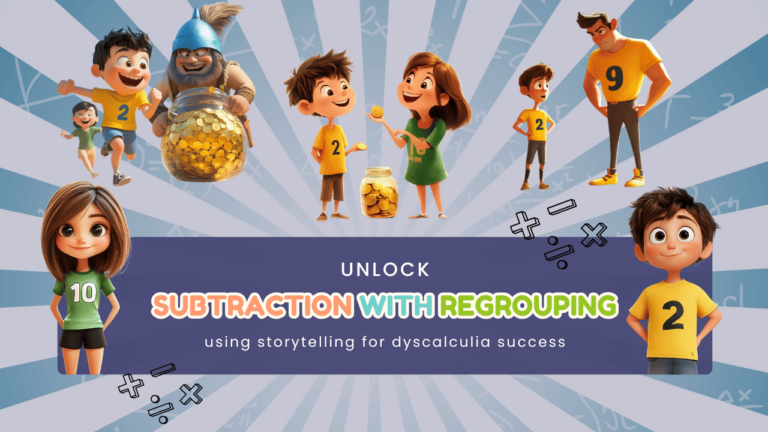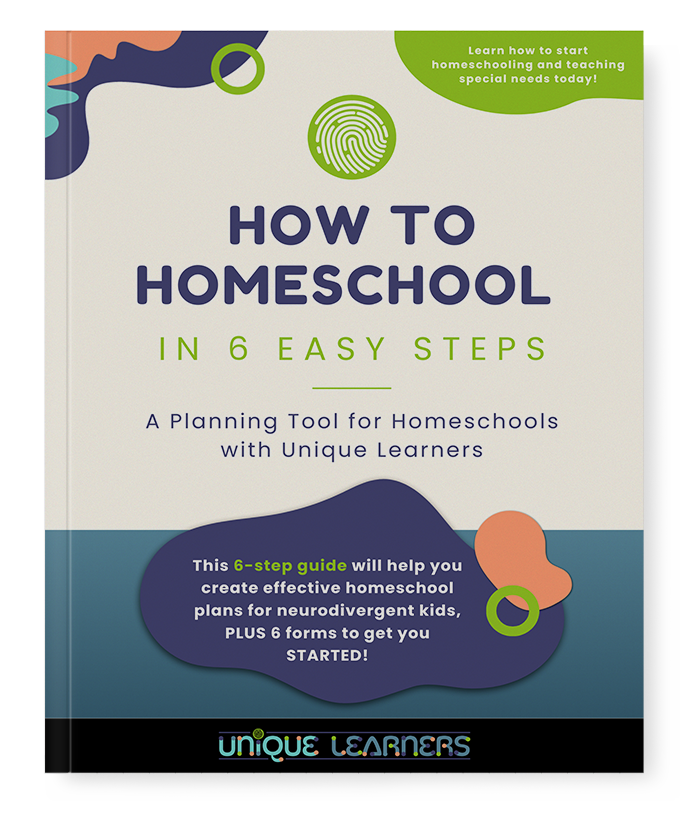Once upon a time, in a world not so different from our own, there was a young mathematician who struggled with numbers. The mere thought of subtraction with regrouping felt like facing a dragon that refused to be tamed. For many children with dyscalculia, understanding the nuances of this mathematical process can feel overwhelmingly complex. But what if we could transform this intimidating concept into an enchanting subtraction story, one that captures the imagination and gently guides young learners through the labyrinth of numbers? In this magical journey of numbers and narratives, we unlock the secrets of subtraction with regrouping, offering homeschool moms innovative tools to help their children conquer the challenges posed by subtraction.
Stories have long been a powerful medium for unlocking understanding, especially for children with dyscalculia who have difficulty understanding the “language of mathematics.” By weaving tales that feature relatable characters, engaging plots, and memorable adventures, we can break down the barriers of traditional math instruction. Imagine a story where numbers are characters embarking on a quest, each with its own role to play in the grand scheme of subtraction with regrouping. Through these vibrant narratives, children with dyscalculia can visualize math concepts in a fresh, more accessible way. This blog post will explore how storytelling techniques not only provide clarity but also create an exciting learning environment that enhances comprehension and retention for young minds navigating the challenging realm of mathematics. Dive into the world of storytelling and discover how transforming math into an epic saga can lead to dyscalculia success.
The Power of Narrative: Transforming Math into Storytelling
Stories have a unique power to captivate and engage young minds. By harnessing the power of narrative, we can transform seemingly abstract concepts like subtraction with regrouping into exciting adventures that children with dyscalculia can relate to and understand. Instead of presenting subtraction as a series of rules and procedures, we can introduce it as a thrilling journey where numbers come alive.
Create a world where numbers or place value positions are characters with distinct personalities and roles and settings. The hero, “Shorty,” sets out on a quest to solve a problem. Along the way, he encounters obstacles that require him to regroup with his friends, “Tina” and “The Hun.” Together, they combine their strengths to overcome challenges and reach their goal.
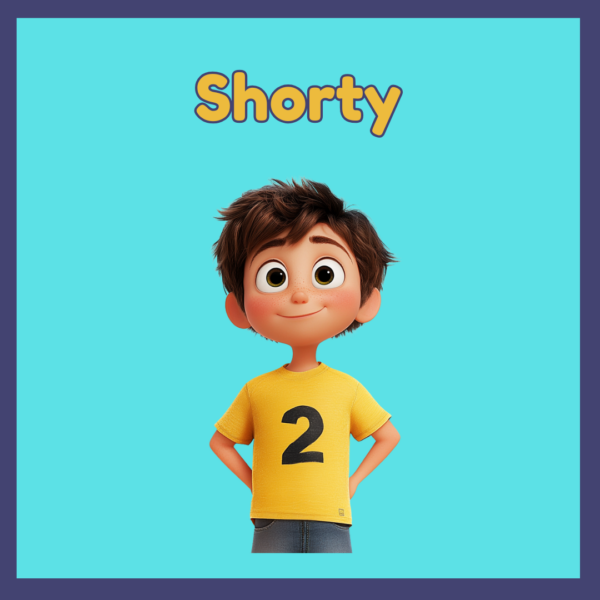
This storytelling approach not only makes subtraction more relatable but also helps children visualize the process in a concrete way. They can see how regrouping works through the actions of the characters in the story. By connecting abstract concepts to familiar narratives, we provide children with dyscalculia a bridge between their imagination and mathematical understanding.
Understanding Dyscalculia: Challenges and Strategies
Dyscalculia is a learning disorder that affects an individual’s ability to understand and work with numbers. Children with dyscalculia often struggle with basic arithmetic operations like addition, subtraction, multiplication, and division. Subtraction with regrouping can be particularly challenging for them due to its multi-step nature.
To effectively teach subtraction with regrouping to children with dyscalculia, it’s crucial to understand their specific challenges and implement appropriate strategies. Some common difficulties faced by these learners include:
Crafting Characters: Numbers as Heroes and Villains
In the world of storytelling, characters play a vital role in captivating readers’ attention. The same principle applies when using narratives to teach subtraction with regrouping to children with dyscalculia. By assigning roles and personalities to numbers, we create a cast of characters that children can connect with on an emotional level.
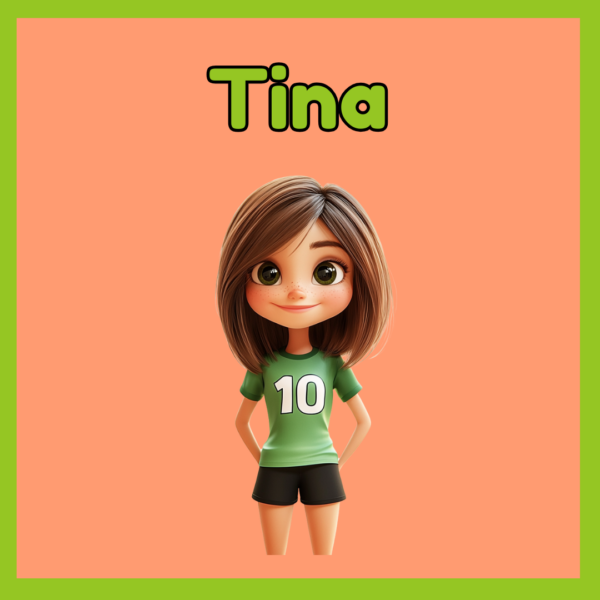
For example, Shorty can be portrayed as a brave hero who always leads the way. Tina and The Hun can be supportive sidekicks who help Shorty overcome obstacles. On the other hand, larger numbers can be depicted as formidable villains or bullies that set up barriers for our heroes.

By personifying numbers in this way, we make them more relatable and memorable for children with dyscalculia. They can develop a deeper understanding of how numbers interact and influence each other during the regrouping process.
Plotting the Adventure: Subtraction with Regrouping Explained
The plot of our story revolves around subtraction with regrouping – a mathematical operation that involves borrowing from one place value column to another when subtracting larger digits. Through engaging storytelling techniques, we can break down this complex process into simpler steps that children with dyscalculia can follow.

Our hero, Shorty, encounters a problem that requires him to subtract two multi-digit numbers. However, he realizes that he doesn’t have enough in his own column to subtract. This is where regrouping comes into play. Shorty seeks the help of his friends, Tina and The Hun, who generously lend him some of their value.
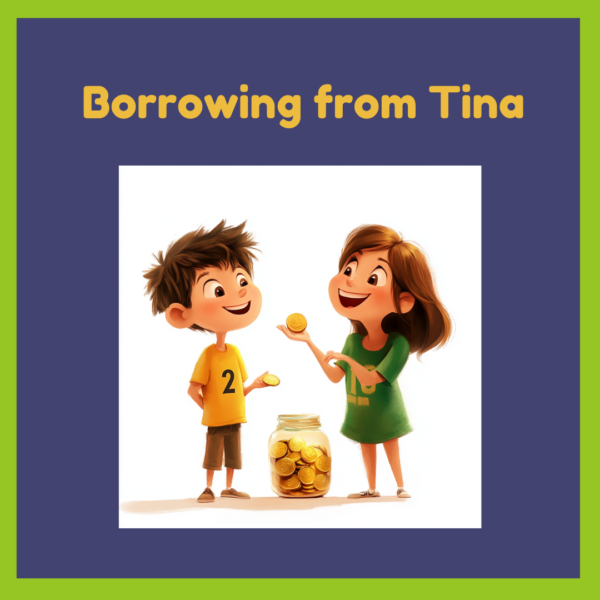
With the borrowed value, Shorty can now subtract the larger digit and continue his quest. The story emphasizes the importance of teamwork and collaboration in solving subtraction problems with regrouping.
By presenting subtraction with regrouping as an exciting adventure, children with dyscalculia can grasp the concept more easily. They can visualize how numbers interact and understand why regrouping is necessary in certain situations.
Subtraction with Regrouping Visualization Techniques: Turning Numbers into Images
For children with dyscalculia, visualizing abstract concepts like subtraction with regrouping can be a significant challenge. However, by incorporating visualization techniques into our storytelling approach, we can help them overcome this hurdle.
One effective technique is to use visual representations such as base-ten blocks or place value charts. These tools provide a concrete way for children to see how numbers are composed and how they interact during the regrouping process.
In our story, we can describe how Shorty borrows blocks from Tina and The Hun to complete his column. Children can imagine these blocks being physically moved from one place value column to another, reinforcing their understanding of regrouping.
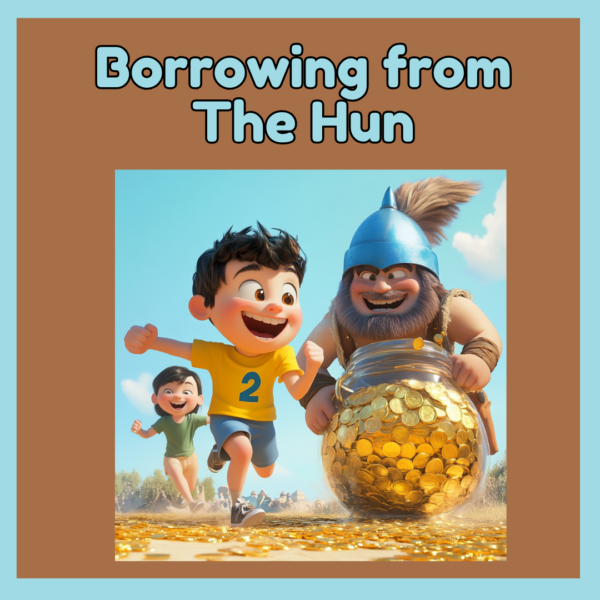
Additionally, using colorful illustrations or drawings alongside the story can further enhance visualization for children with dyscalculia. The pictures become even more meaningful if the student draws them! These visual cues help them connect the narrative to mathematical concepts in a more tangible way.
Engaging the Senses: Multisensory Approaches to Learning
Dyscalculia often affects multiple senses and learning modalities. To accommodate different learning input modes and engage all senses, it’s essential to incorporate multisensory approaches into our storytelling.
For example, while telling the story, we can encourage children to use manipulatives like base-ten blocks or counters to physically represent the numbers and regrouping process. This hands-on experience allows them to engage their sense of touch and reinforces their understanding of subtraction with regrouping.
Incorporating auditory elements like chants or story dialogue that reinforce the steps of subtraction with regrouping can also be beneficial. Children can repeat these chants or say the dialogue aloud, reinforcing their memory of the process through auditory cues.
By appealing to multiple senses, we create a rich learning experience that caters to the diverse needs of children with dyscalculia. This multisensory approach enhances their comprehension and retention of mathematical concepts.
Overcoming Obstacles: Addressing Common Misconceptions
When teaching subtraction with regrouping, it’s important to address common misconceptions that children with dyscalculia may have. By debunking these misconceptions through storytelling, we can ensure a more accurate understanding of the concept.
One common misconception is that subtracting larger digits always requires regrouping. In our story, we can introduce scenarios where Shorty doesn’t need to borrow from his friends because there is enough in his column to subtract. This helps children understand that regrouping is only necessary when there isn’t enough in a column.
Another common misconception is that subtraction can happen from the bottom up because we subtract the smaller number from the larger number. Again the story helps that Shorty can either breeze past bottom number by subtracting without regrouping or get stalled at a “Bully” blockade and take the detour to borrow.
Another misconception is where to bring the borrowed value. If Tina is has zero power, the The Hun can provide some power. The student must break up The Hun’s power to share with Tina before returning to his own column. Everyone’s a winner when we regroup!
By proactively addressing misconceptions through storytelling, we prevent confusion and build a solid foundation for understanding subtraction with regrouping.
Interactive Storytelling: Games and Activities for Hands-On Learning
Interactive games and activities can further enhance the learning experience for children with dyscalculia. By incorporating these elements into our storytelling approach, we create opportunities for hands-on learning and active engagement.
For example, we can design a board game where children move their character (Shorty) along a path, encountering subtraction problems with regrouping along the way. They can use manipulatives or visual aids to solve these problems, reinforcing their understanding of the concept.
Another activity could involve creating a comic strip or storyboard based on the story. Children can illustrate each step of the regrouping process and write captions to explain their thinking. This activity encourages them to reflect on their understanding and solidify their knowledge through creative expression.
A very real-life, practical activity is to use real coins of dollars, dimes, and pennies to do the exchanges. You can even play “store” or shopping with older kids as long as the items for purchase are in their interests.
Or create a class activity where kids act out the digits of power in their place value columns. You may want to have vests with velcro tabs for ones, tens, and hundred values.
By incorporating interactive games and activities, we make learning subtraction with regrouping an enjoyable and immersive experience for children with dyscalculia.
The Enchanting Finale: Empowering Children for Dyscalculia Success with Subtraction with Regrouping
As our story comes to a close, children with dyscalculia emerge as empowered mathematicians who have conquered the challenges of subtraction with regrouping. Through the power of narrative, we have transformed a daunting concept into an enchanting adventure that sparks their imagination and ignites their mathematical understanding.
By using storytelling techniques, homeschool moms can provide their children with friendly math tools to navigate the world of mathematics. Through relatable characters, engaging plots, and multisensory experiences, children with dyscalculia can overcome obstacles and unlock their full potential.
So, let us embark on this magical journey together and unleash the power of storytelling to unlock subtraction with regrouping for children with dyscalculia. With every tale we weave, we bring them one step closer to a future filled with mathematical success.
Grab your FREE e-book guide to revamp your homeschool for success!
Are you new to homeschooling, or just wanting a fresh start? Download our FREE “How to Homeschool in 6 Easy Steps” guide and get valuable insights from Sue’s 30+ years of experience as a special educator and homeschool mom of 4!
Want to know about new products and blogs?
Join our email newsletter to be the first to know about a new homeschool and special needs blog, and new products from our shop! Sign up for only the newsletter, or grab your FREE “How to Homeschool in 6 Easy Steps” guide and you will also be added to the newsletter!
Also, join our Facebook group!
Join our new “Homeschool Help for Special Needs” Facebook group! It is a place for homeschool moms to ask questions about homeschooling a child with special learning needs, share teaching and curriculum ideas that have worked (and those that bombed), and be real about the unique challenges of homeschooling with special needs. If you want to join us, be sure to answer the member questions to help us keep this private group secure. Join us now!
